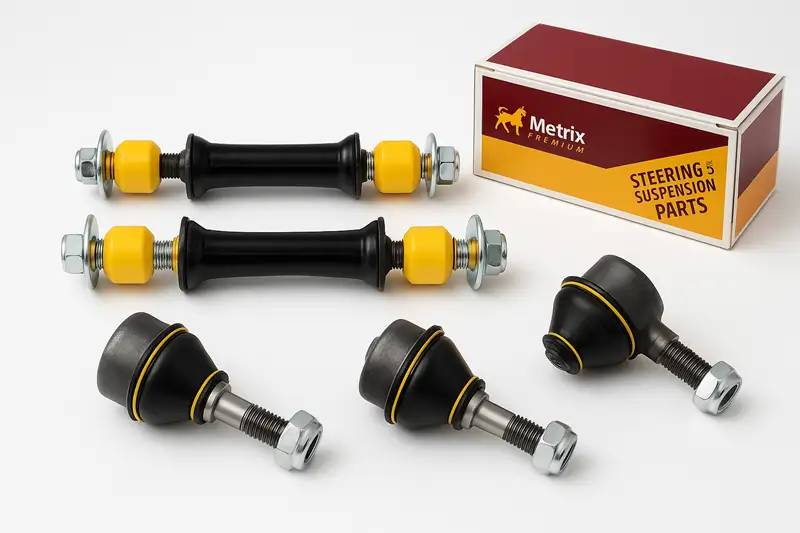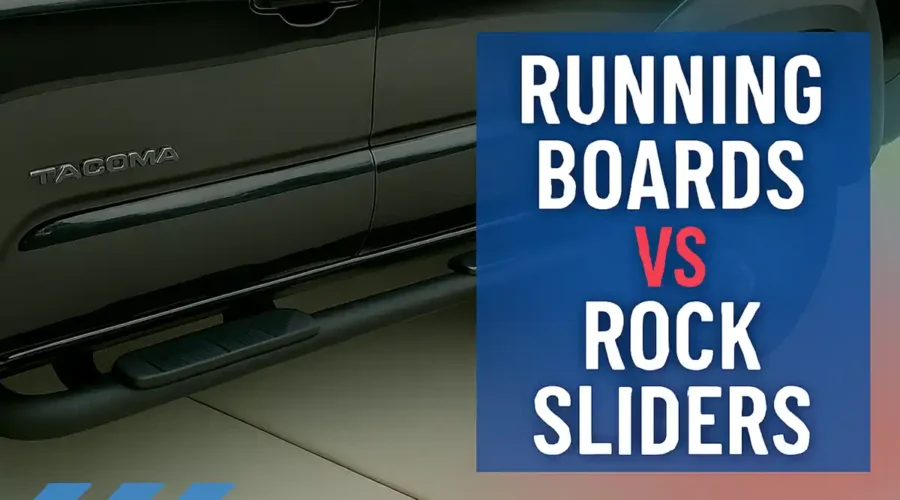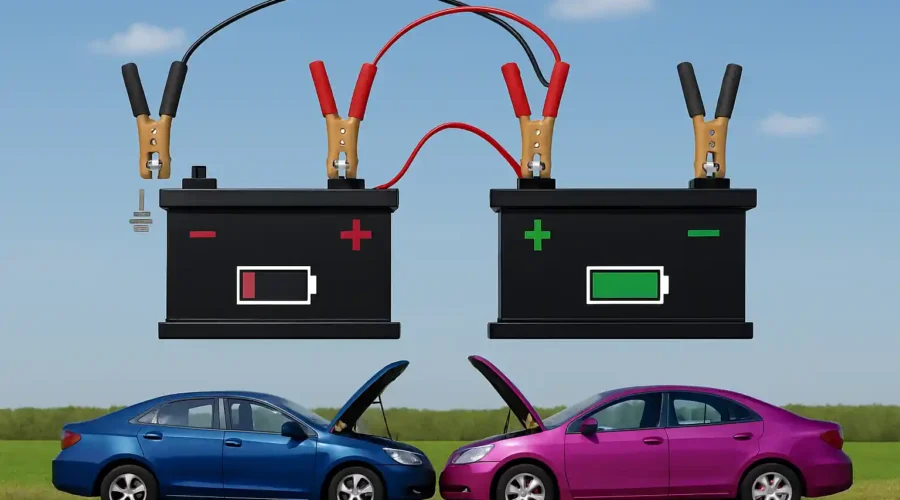What happens when a car takes a sharp corner? The sway bar and stabilizer link come into play. These components work together to enhance the vehicle’s stability and control during such maneuvers. They are vital for ensuring a smooth and safe ride.
The sway bar, also known as an anti-roll bar, connects the left and right wheels and reduces body roll. On the other hand, the stabilizer link, also called the sway bar link, connects the sway bar to the vehicle’s suspension system. This synergy is crucial, as a broken stabilizer link can compromise the effectiveness of the sway bar by up to 70%. Together, they provide a significant improvement in the handling and performance of modern vehicles.
Sway bars, also known as anti-roll bars, reduce body roll in vehicles during cornering by linking the suspension on either side. Stabilizer links connect sway bars to the suspension components, ensuring effective force transfer and vehicle stability. Both components work together for improved handling and safety.
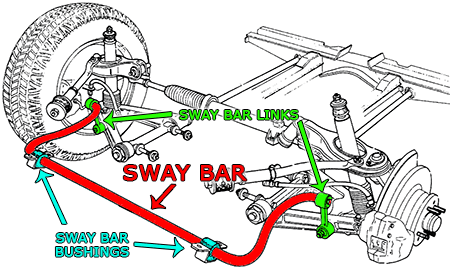
Understanding the Function of a Sway Bar in Vehicle Dynamics
A sway bar, also called an anti-roll bar, is a crucial component in a vehicle’s suspension system. It helps reduce body roll when a car goes around a corner. This gives the driver more control and makes the ride safer. The sway bar essentially balances the suspension on both sides of the vehicle.
When a car turns, the sway bar connects the opposite wheels. This connection keeps the car’s body from leaning too much. The result is a smoother ride and better handling. Without it, the car would feel less stable and more likely to tip.
Sway bars are usually made of metal and are attached to the chassis. They work by twisting to counteract the force that creates body roll. This twisting action helps keep both wheels on the ground, giving better traction. It’s a simple yet effective way to improve vehicle dynamics.
Many people don’t notice the sway bar until it fails. Signs of a bad sway bar include clunking noises and poor handling. If you suspect an issue, it’s best to get it checked out. Properly functioning sway bars are essential for a safe and comfortable drive.
BAD SWAY BAR LINK SOUND! | Simple-Fast-Professional-DIAGNOSIS
Essential Role in Minimizing Body Roll
A sway bar’s primary function is to minimize body roll when a vehicle makes a turn. By linking the wheels on either side of the car, it distributes force evenly across the suspension. This helps to keep the vehicle more level. The driver experiences better control and handling, especially during sharp turns.
Without a sway bar, a car would lean significantly more in corners. This not only feels uncomfortable but can also be unsafe. The increased body roll could cause a loss of traction. Thus, sway bars are critical for maintaining vehicle stability. They are particularly important for taller vehicles like SUVs.
Another benefit is the sway bar’s ability to enhance ride comfort. By reducing the car’s tendency to lean, it helps the passengers experience a smoother ride. The sway bar absorbs some of the forces that would otherwise jolt the vehicle. This makes long trips more pleasant for everyone on board.
Many performance vehicles come with stiffer sway bars. These bars further reduce body roll and improve handling. For everyday cars, a standard sway bar does an excellent job. Whether on a racetrack or regular road, sway bars are essential for a safe and comfortable drive.
Impact on Vehicle Stability during Sharp Turns
During sharp turns, vehicle stability is crucial for safety. One key factor that enhances this stability is the sway bar. It works to keep the car balanced by reducing the body roll. This ensures that the vehicle’s tires maintain better contact with the road.
Without a sway bar, the vehicle could lean dangerously during a turn. This would reduce traction and make it harder to control. The sway bar helps distribute the forces across the suspension system evenly. By doing so, turning becomes smoother and more predictable.
Performance cars often have stiffer sway bars to handle sharp turns more effectively. These bars provide a firmer response, improving the car’s overall grip on the road. However, even standard cars benefit greatly from their sway bars. They make everyday driving more stable and comfortable.
In addition to sway bars, stabilizer links play a significant role in maintaining vehicle stability. By connecting the sway bar to the suspension, they ensure that the system operates correctly. Together, these components significantly improve the handling and safety of any vehicle. For these reasons, properly functioning sway bars and stabilizer links are essential.
Differences in Design and Material
Design and material choices greatly affect the performance of sway bars and stabilizer links. Sway bars are typically metal rods that connect the suspension on both sides of the vehicle. They can come in different shapes, such as solid or tubular. The choice of design impacts the strength and weight.
Stabilizer links, on the other hand, link the sway bar to the vehicle’s suspension. They are usually smaller and can be made of metal or a combination of metal and rubber. The materials used affect the durability and flexibility of these parts. The main goal is to ensure reliable performance in various driving conditions.
Manufacturers often use different types of metals for sway bars. Common materials include steel and aluminum. Steel is strong and durable but can add more weight. Aluminum is lighter, which can improve overall vehicle performance.
Some sway bars are adjustable, allowing for fine-tuning of the suspension system. This feature is especially popular in high-performance and racing cars. Adjustable sway bars give drivers the flexibility to modify their car’s handling. It’s an added layer of customization that can significantly improve driving experience.
In contrast, stabilizer links generally do not offer adjustability. They are built to specific dimensions for each vehicle model. Replacement options are available for both sway bars and stabilizer links. Brands like Moog Parts and Monroe Suspension provide high-quality options for various needs.
To summarize, the differences in design and material between sway bars and stabilizer links play a crucial role. These factors influence everything from the car’s stability and handling to the longevity of the parts. Understanding these differences helps in choosing the right components for your vehicle. Proper selection ensures safety and enhances driving performance.
What is a Stabilizer Link and How Does it Support the Sway Bar?
A stabilizer link, also known as a sway bar link, connects the sway bar to the suspension components. It acts as a bridge between the sway bar and the control arms or struts. The main function is to ensure that the sway bar can do its job effectively by transferring movement and forces. This helps keep the car stable and reduces body roll.
Stabilizer links come in various designs and materials. Some are made from steel, while others use a combination of metal and rubber. These materials provide the necessary strength and flexibility for different driving conditions. The design can vary between straight and curved links, depending on the vehicle’s suspension layout.
When a car turns, the stabilizer link transfers the force from the sway bar to the suspension system. This action helps maintain balance and prevents excessive leaning. Without a functional stabilizer link, the sway bar would not work properly, leading to poor vehicle handling. Therefore, it’s crucial for both parts to be in good condition.
Stabilizer links are subject to wear and tear over time. Common symptoms of a failing stabilizer link include clunking noises and reduced stability. Regular inspections can help identify issues early, ensuring the sway bar remains effective. Replacement of worn-out links is relatively straightforward and can restore proper function.
High-quality stabilizer links can improve the overall driving experience. Brands like Moog Parts and Monroe Suspension offer reliable options. These aftermarket parts often provide better durability than the original ones. Choosing the right stabilizer link enhances safety and performance on the road.
In summary, stabilizer links play a vital role in supporting the sway bar. They ensure that the suspension system works smoothly, providing better vehicle stability and handling. Regular maintenance and choosing high-quality parts can extend their lifespan and keep your vehicle safe. Proper functioning of these components is essential for a comfortable and secure drive.
Comparative Analysis: Sway Bar vs Stabilizer Link
A sway bar and a stabilizer link are both essential components in a car’s suspension system. While they work together to improve vehicle stability, they serve different functions. The sway bar reduces body roll during turns, enhancing overall handling. The stabilizer link connects the sway bar to the suspension, ensuring it can function correctly.
The design of these components is distinct. The sway bar is a long, metal rod that extends across the vehicle’s width. It connects to both sides of the suspension. Stabilizer links, however, are shorter and connect the sway bar to the control arm or strut. This connection helps transfer the forces generated during cornering.
Sway bars are generally made of materials like steel or aluminum. They need to be strong to handle the stress of sharp turns. Stabilizer links can be made from metal or a combination of metal and rubber. This material choice allows some flexibility and reduces the chances of breakage.
Replacement and maintenance differ for these components. Sway bars are durable, but they can wear out over time. Stabilizer links typically wear out faster due to their smaller size and continual movement. Regular inspections can help identify issues before they escalate, ensuring both components work well together.
In terms of cost, replacing stabilizer links is usually cheaper. However, both parts are crucial for a well-functioning suspension system. Ignoring issues with either can lead to poor handling and reduced safety. Hence, prompt replacement of faulty parts is recommended.
Ultimately, understanding the roles of sway bars and stabilizer links helps in maintaining vehicle safety and performance. Both are essential for reducing body roll and improving stability, making them key components in any vehicle’s suspension system. Regular checks and timely replacements ensure they continue to perform effectively.
Common Signs of a Failing Sway Bar
A failing sway bar can significantly affect vehicle performance and safety. One of the first signs is unusual noises, typically clunking or rattling sounds from underneath the car. These noises often become more noticeable when driving over bumps or during turns. It indicates that the sway bar or its links are loose or damaged.
Another common symptom is poor handling and increased body roll. The car may feel less stable during maneuvers, especially around corners. This reduced stability makes it challenging to control the vehicle, increasing the risk of accidents. If you notice such changes in driving behavior, it’s time to inspect your sway bar components.
Uneven tire wear can also signal issues with the sway bar system. When the sway bar isn’t functioning correctly, it can’t distribute forces evenly across the suspension. This leads to excessive load on certain tires, causing them to wear out faster than others. Regular tire checks can help identify this problem early.
Besides uneven tire wear, visual inspection can reveal broken or worn-out parts. Look for cracks or damage in the sway bar itself and its bushings and links. Replacing worn-out components promptly ensures they don’t compromise vehicle safety further.
Failing sway bars can cause difficulty maintaining a straight line while driving. The vehicle might drift or pull to one side, requiring constant steering adjustments. This issue could be due to a damaged sway bar affecting wheel alignment.
If you experience any of these symptoms, it’s essential to address them immediately for a smooth and safe drive.
Diagnosing Issues with Stabilizer Links
Diagnosing problems with stabilizer links can help maintain your car’s stability and handling. One of the most obvious signs of a problem is a rattling noise. If you hear clunking sounds when driving over bumps, the stabilizer links may be loose or worn out. This noise often points to a need for immediate inspection.
Another sign is a change in how the car handles corners. If your car feels less stable or sways excessively, the stabilizer links could be failing. This problem affects the overall performance of the sway bar. Checking the links can confirm if they are the source of the instability.
Visual inspection is an effective way to diagnose stabilizer link issues. Look for signs of wear or damage to the links and their bushings. Cracks, rust, or looseness could indicate a problem. Replacing damaged parts can restore the proper function of the sway bar and improve handling.
Monitoring tire wear patterns can also help diagnose stabilizer link issues. Uneven tire wear may result from improperly functioning links, leading to poor force distribution across the suspension. Regularly inspecting your tires can help detect this early, allowing for prompt repairs.
If you suspect an issue but can’t confirm it visually, consider a professional inspection. Mechanics have tools and expertise to diagnose stabilizer link problems accurately. They can also provide a more thorough check of related suspension components. Addressing these problems early can prevent further damage and ensure a safer ride.
Repair and Replacement Tips for Sway Bars and Stabilizer Links
Repairing and replacing sway bars and stabilizer links can be straightforward if you know what to look for. Start by identifying any obvious damage or wear. Cracks, bent parts, or loose connections are clear signs that replacement is necessary. Always use high-quality parts to ensure durability and performance.
When replacing a sway bar, first lift the vehicle safely and securely. Remove the old sway bar by disconnecting it from the suspension and chassis. Install the new sway bar, making sure to tighten all bolts properly. This will ensure it functions correctly and lasts longer.
For stabilizer links, follow a similar process. Safely lift the vehicle and locate the stabilizer links connected to the sway bar and suspension. Remove the worn or damaged link and replace it with a new one. Tightening the bolts securely is crucial to avoid any future issues.
Regular maintenance can extend the life of these components. Inspect sway bars and stabilizer links during routine vehicle checks. Look for any signs of wear or looseness and address them promptly. This proactive approach helps maintain your vehicle’s handling and stability.
If you’re unsure about performing these repairs yourself, consider professional assistance. Mechanics have the tools and expertise to do the job efficiently. They can also inspect other related suspension components, ensuring your vehicle remains safe and in top condition. Keeping your sway bars and stabilizer links in good shape is key to a smooth and safe ride.
Impact of Aftermarket Upgrades on Sway Bars and Links
Aftermarket upgrades for sway bars and stabilizer links can drastically improve a vehicle’s performance. These parts are designed to be stronger and more durable than the factory-installed versions. Upgraded sway bars deliver better handling by reducing body roll even further. This enhances the driving experience, especially during sharp turns or on rough terrain.
Performance-oriented aftermarket sway bars are often adjustable. This adjustability allows for fine-tuning to match different driving conditions and preferences. Drivers can choose settings for everyday comfort or aggressive driving. The flexibility provided by these adjustable sway bars offers a custom driving experience.
Upgraded stabilizer links also provide significant benefits. Constructed from high-quality materials, these links are designed to withstand greater forces. They provide a more direct connection between the sway bar and suspension. This results in better vehicle response and improved cornering stability.
Many drivers notice immediate improvements after installing aftermarket sway bars and links. The car feels tighter and more responsive. This can be especially beneficial for sports cars and off-road vehicles. Enhanced stability and control provide a safer and more enjoyable drive.
Although aftermarket upgrades can be more expensive, the investment often pays off. The increased performance and durability reduce the need for frequent repairs or replacements. This long-term reliability makes aftermarket sway bars and stabilizer links a popular choice among car enthusiasts.
Choosing the right aftermarket parts requires careful consideration. Brands like Moog Parts and Monroe Suspension offer reliable options. Researching and selecting high-quality products ensure optimal performance. With the right upgrades, any vehicle can achieve better handling and stability.
Future Innovations in Sway Bar and Stabilizer Link Technology
Technology in sway bars and stabilizer links is evolving rapidly. One exciting development is the use of advanced materials. These new materials are lighter yet stronger than traditional steel. They promise to enhance vehicle performance while reducing weight. This can lead to better fuel efficiency and improved handling.
Another innovation is the introduction of active sway bars. These smart sway bars can adjust their stiffness in real time. They respond to driving conditions and driver inputs, providing optimal balance. This technology improves comfort on normal roads and enhances performance during aggressive driving.
Electric stabilizer links are also on the rise. These links use electric actuators to adjust the sway bar’s position actively. This precise control improves vehicle stability and handling. Electric links are particularly beneficial for off-road and performance vehicles.
Manufacturers are also exploring integration with vehicle sensors. Future sway bars and links could work seamlessly with a car’s electronic stability control system. This integration would provide even better handling and safety features. It represents a significant step forward in automotive technology.
Customizable systems may become more common. Drivers could potentially adjust settings through a smartphone app or in-car controls. This user-friendly approach makes advanced suspension technology accessible to everyone. Custom settings can be tailored for specific driving styles and conditions.
The future of sway bars and stabilizer links looks promising with these innovations. As technology advances, we can expect even better performance and safety from our vehicles. These improvements will make driving more enjoyable and secure for everyone on the road.
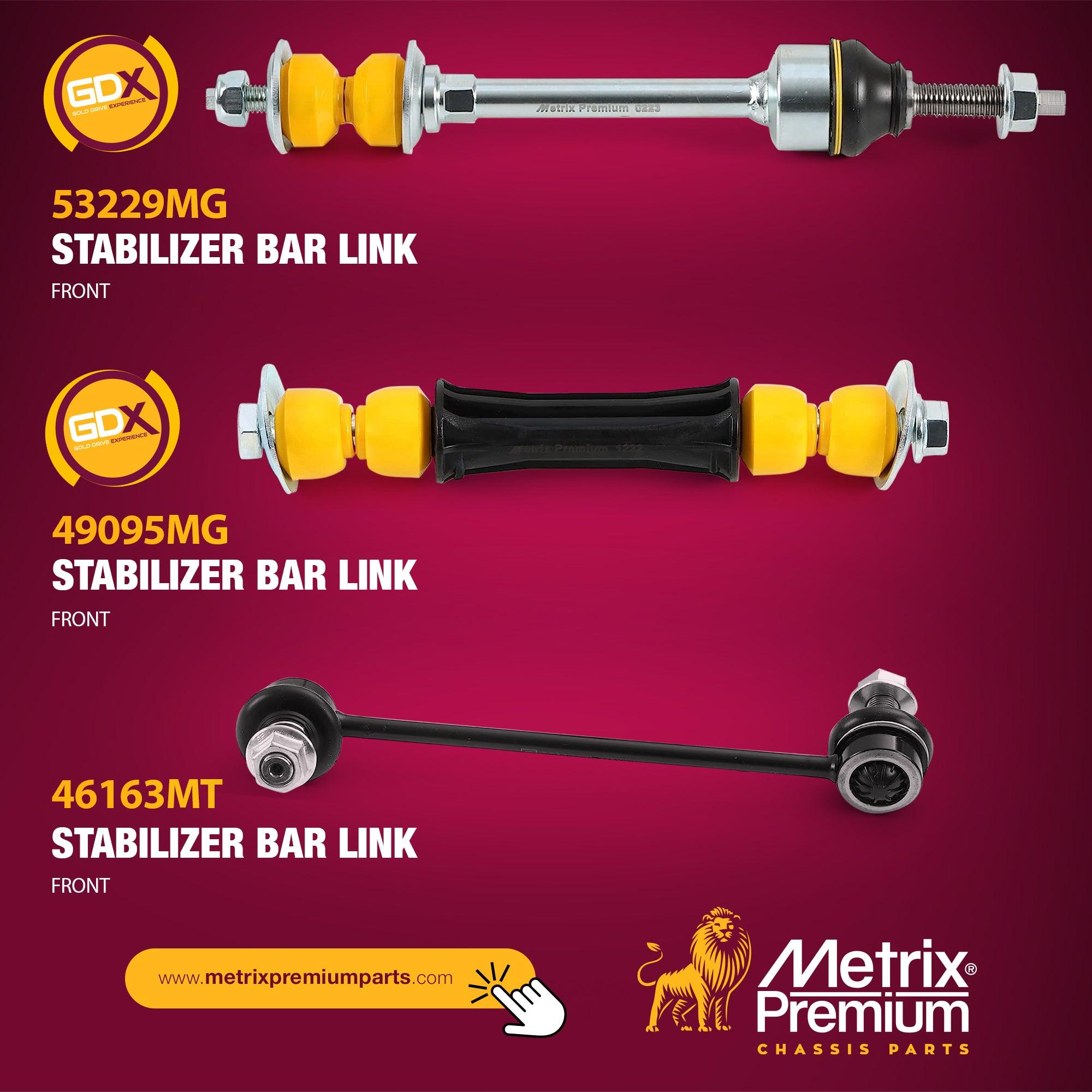
Frequently Asked Questions
Here are some essential questions and answers about sway bars and stabilizer links. These will help you understand their functions and importance in vehicle dynamics.
1. What are the symptoms of a bad sway bar?
Common symptoms of a bad sway bar include clunking noises and poor handling. You might notice these sounds when driving over bumps or during sharp turns. Reduced stability and increased body roll can also indicate issues with the sway bar. Getting these symptoms checked promptly can prevent further damage. Ignoring these symptoms might lead to uneven tire wear and increased risk of accidents. A visual inspection can help identify any visible damage or wear. Thus, it's best to consult a professional if you suspect any issues with your sway bar.
2. How often should stabilizer links be replaced?
Stabilizer links generally last around 50,000 to 70,000 miles, but their lifespan can vary. Factors such as driving conditions and road quality significantly impact their durability. Regular inspection during routine maintenance can help catch wear early. Replacing them at the first sign of trouble can save you from bigger problems. If you hear clunking noises or experience handling issues, it might be time for a replacement. Some drivers prefer aftermarket options for better longevity and performance. Always consult your vehicle’s manual or a professional for accurate advice on replacement schedules.
3. Are aftermarket sway bars worth it?
Aftermarket sway bars can offer significant improvements in vehicle handling and stability. They are often stiffer and more durable than factory-installed sway bars. This makes them particularly valuable for performance and off-road driving. Consider your driving needs before investing in aftermarket parts. However, they might not be necessary for everyday driving. Weigh the benefits against the cost. For the best results, go for reputable brands that offer a good warranty and quality assurance.
4. Can I replace stabilizer links myself?
Replacing stabilizer links can be a manageable task if you have basic automotive skills. You'll need to safely lift the vehicle and remove the old links. Installing the new ones involves tightening the bolts securely. Follow the vehicle’s manual for proper procedures. However, if you are unsure or lack the necessary tools, it’s best to seek professional help. Incorrect installation can lead to further issues. Professional mechanics can ensure the job is done right and catch any other potential problems.
5. How do sway bars improve vehicle handling?
Sway bars improve vehicle handling by reducing body roll during turns. They connect the suspension on either side, distributing forces more evenly. This results in better tire contact with the road, providing more stability. Drivers experience a more controlled and smoother ride, especially during sharp maneuvers. Without a sway bar, vehicles would lean excessively during turns, making them harder to control. This is especially important for sports and off-road vehicles. Sway bars and stabilizer links work together to ensure optimal handling performance.
Mevotech (TTX) Stabilizer Bar vs OEM Comparison
Conclusion
Sway bars and stabilizer links are essential for vehicle stability and handling. Understanding their roles and maintaining them properly can enhance driving safety. Regular inspections and timely replacements ensure these components work effectively.
Aftermarket options can offer performance improvements for those seeking enhanced driving experiences. Keeping these parts in optimal condition is key to achieving a smooth and controlled ride. Their importance in modern vehicle dynamics cannot be overstated.

